

Online transactions carried out on mobile devices are expected to grow by $11.1 billion this year in the Philippines, giving the local digital commerce sector a big boost, according to estimates from payments solutions provider UnaCash.
This means this segment—also known as mobile commerce (m-commerce)—is projected to grow by 20.4 percent year-on-year to $9.2 billion in 2024, UnaCash said in a statement on Wednesday.
Article continues after this advertisementExplaining its bullish outlook on the local m-commerce scene, UnaCash, which offers installment loans in the Philippines, said a key growth driver for this segment is the demand for “buy now, pay later” or BNPL products.
FEATURED STORIES BUSINESS Weak peso might delay BSP easing BUSINESS PH leads Asean in vehicle production growth in September BUSINESS PH, Saudi Arabia see power tie-up materializing in three monthsBNPL refers to a payment option whereby customers can avail of short-term installment loans at the point of sale. This product, UnaCash explained, would corner 30 percent of the total volume of m-commerce transactions next year amid a high smartphone penetration rate in the Philippines that’s making e-wallets more popular in the country, especially among young Filipinos.
READ: PH’s internet economy post fastest growth among SEA — report
Article continues after this advertisementUnaCash estimates that there are about 87.4 million digital commerce users in the country.
Article continues after this advertisement“This growth signals a critical turning point for retailers, a move where adopting mobile-first strategies such as integrating BNPL options can not only capture the growing digital audience but also enhance customer satisfaction,” Erwin Ocampo, head of product at UnaCash, said.
Article continues after this advertisement”This also includes driving repeat purchases and staying competitive in an increasingly mobile-driven economy,” Ocampo added.
Latest data from the Bangko Sentral ng Pilipinas (BSP) showed the share of digital payments to total retail payment transactions in the country had grown to 52.8 percent in 2023, from 42.1 percent in 2022. That means out of the 5 billion total monthly transactions recorded last year, more than 2.6 billion of them had been successfully converted to digital form.
It was a feat that exceeded the expectations of the central bank, which had hoped to digitalize 50 percent of retail payments in the country by 2023. This, in turn, bodes well for the BSP’s goal to onboard 70 percent of adult Filipinos to the formal financial system by 2023.
Subscribe to our daily newsletter

